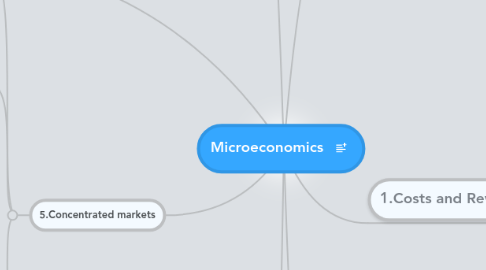
1. 4.Efficiency
1.1. Types
1.1.1. Dynamic
1.1.1.1. occurs over a period of time
1.1.1.1.1. productive, allocative and x
1.1.2. Static
1.1.2.1. in a given moment in time
1.1.2.1.1. product and process
1.1.3. Allocative
1.1.3.1. Occurs where output is made in line with consumer prefernces
1.1.4. Productive
1.1.4.1. lowest point of the AC curves
1.1.5. X inefficiency
1.1.5.1. where a firm fails to produce on its average costs curbe due to organisational slack
1.2. Deadweight loss
1.3. Surplus
1.3.1. Consumer
1.3.1.1. difference between the price a consumer is willing to pay and the market price
1.3.2. Producer
1.3.2.1. Differeence between the market price and the pruice at which a producer is willing to supply
2. 3.Perfect Competition
2.1. Assumptions
2.1.1. Many Buyers and sellers
2.1.2. No economies of scale
2.1.3. No externalities
2.1.4. No barriers to exit and entry
2.1.5. Perfect information
2.1.6. Identical Products
2.2. Sunk Costs
2.2.1. A cost which cannot be recovered, i.e. advertising
2.3. Shutdown Cnition
2.3.1. P<AVC (long run, short run)
2.4. Factors of competition
2.4.1. Research and development
2.4.2. Range
2.4.3. Brand
2.4.4. Quality
2.4.5. Location
2.4.6. Customer Service
2.4.7. Loyalty
3. 5.Concentrated markets
3.1. Concentration ratio
3.1.1. C.R.5-value of output from the 5 largest firms
3.2. Why firms grow larger?
3.2.1. Market power motive
3.2.2. Key managerial objective
3.2.3. Profit motive
3.2.4. Benefit from economies of scale
3.2.4.1. increases productive capacity
3.2.4.2. competitive edge in markets
3.2.5. risk motive
3.3. How do they grow larger?
3.3.1. Internal growth
3.3.1.1. Profits, loans of a company re-invested back and expansion occurs.
3.3.1.2. Caffe Nero
3.3.2. External growth
3.3.2.1. Mergers
3.3.2.1.1. Horizontal
3.3.2.1.2. Vertical
3.3.2.1.3. Lateral
3.3.2.1.4. Conglomerate
3.3.3. Outsourcing
3.3.3.1. technological change
3.3.3.1.1. just in time
3.3.3.2. increased competition
3.3.3.3. pressure from financial markets
4. 7.Monopoly
4.1. greater than 25% market share
4.2. how to define
4.2.1. number of substitutes
4.2.2. level of barriers to entry
4.2.2.1. High Fixed costs
4.2.2.2. Economies of scale
4.2.2.3. Brand loyalty
4.2.2.4. Legal barriers
4.2.2.5. Control over factors of production
4.2.2.6. Control over retail
4.2.2.7. Predator pricing
4.2.3. degree of product differentiation
4.3. Efficiency
4.3.1. Allocatively ineffiecient
4.3.1.1. P>MC
4.3.2. X inefficient
4.3.2.1. barriers to entry absence of competitive forces
4.4. Costs
4.4.1. Abnormal profits at the expense of efficiency
4.4.2. loss of allocative efficiency
4.4.3. productive and X inefficiency
4.5. Benefits
4.5.1. Economies of scale
4.5.1.1. lower prices
4.5.2. Natural Monopoly
4.5.2.1. M.E.S reached
4.5.3. Dynamic efficiency from supernormal profits
4.5.4. Scope to be internationally competitive
5. 2. Profit Maxmisation
5.1. Managerial Theories
5.1.1. Managerial Status
5.1.2. Revenue maximisation
5.2. Profit
5.2.1. Normal Profit
5.2.1.1. sufficient to all the factors of production in business
5.2.1.2. Occurs at AC=AR
5.2.2. Supernormal Profit
5.2.2.1. Occurs as profit above that of normal profit
5.3. Role of Profit
5.3.1. Investment
5.3.2. Economic performance indicator
5.3.2.1. New node
5.3.3. Innovation promted
5.3.4. Signal for market entry
5.3.5. Allocation of factors of production
6. 1.Costs and Revenues
6.1. Short Run
6.2. Types of Costs
6.2.1. Average Costs
6.2.1.1. Note: ATC is the addition of AFC and AVC
6.2.2. Variable costs
6.2.2.1. the costs of employing the variable factors within the short run (wages)
6.2.3. Fixed Costs
6.2.3.1. cost of employing fixed facotors int the short run i.e. cost of maintenance
6.2.4. total cost = total fixed cost + total variable cost
6.3. Law of Diminshing returns
6.3.1. Occurs when more units of a variable factor are added to a fixed factor so marginal product decreases
6.3.1.1. Personal Todo List
6.3.1.2. Vacation Planning
6.3.1.3. Meeting Minutes
6.3.1.4. Project Plan
6.3.1.5. more...
6.4. Economies of scale
6.4.1. Increase in input will lead to a more than proportional increase in output, falling LRAC curve
7. 6.Price Discrimination
7.1. occurs when a producer sells an identical product to different buyers at different pirces for reasons unrealted to costs
7.2. Conditions
7.2.1. differences in elasticity
7.2.2. barriers to prevent "market seepage"
7.3. Types
7.3.1. First degree
7.3.1.1. charging each individual consumer the maximum they are prepared to pay, i.e. unique price for each individual unit
7.3.1.1.1. ebay
7.3.2. Second degree
7.3.2.1. selling batches of a product at lower price than previous
7.3.2.1.1. cinema tickets
7.3.3. Third degree
7.3.3.1. Multi-Market- different segments of market different prices
7.3.3.1.1. train tickets
7.4. Impact on surplus
7.4.1. Consumer
7.4.1.1. reduced- loss in consumer welfare.
7.4.1.2. Lower-income can be "priced into the market"
7.4.2. Producer
7.4.2.1. Monopoly os extracting consumer surplus turning into supernormal profit
